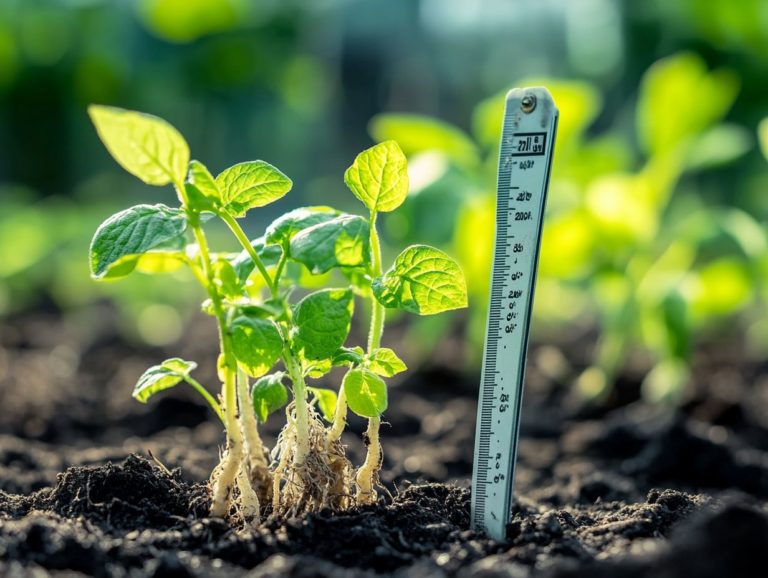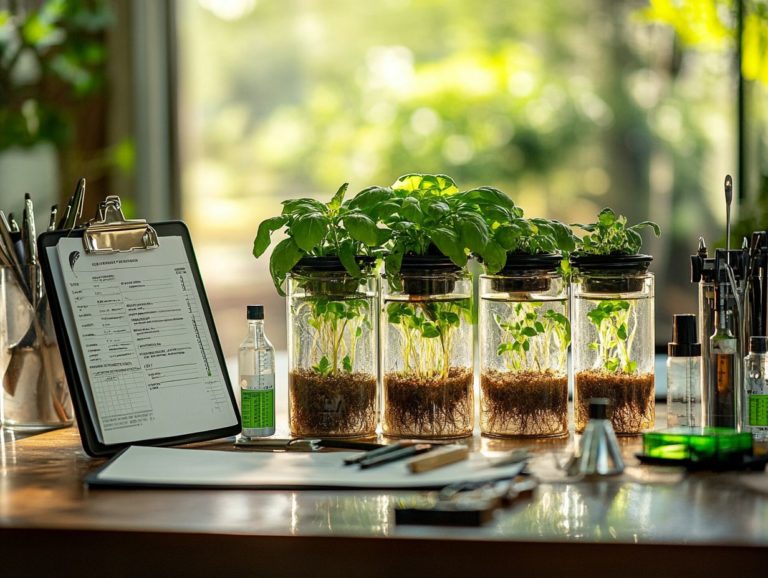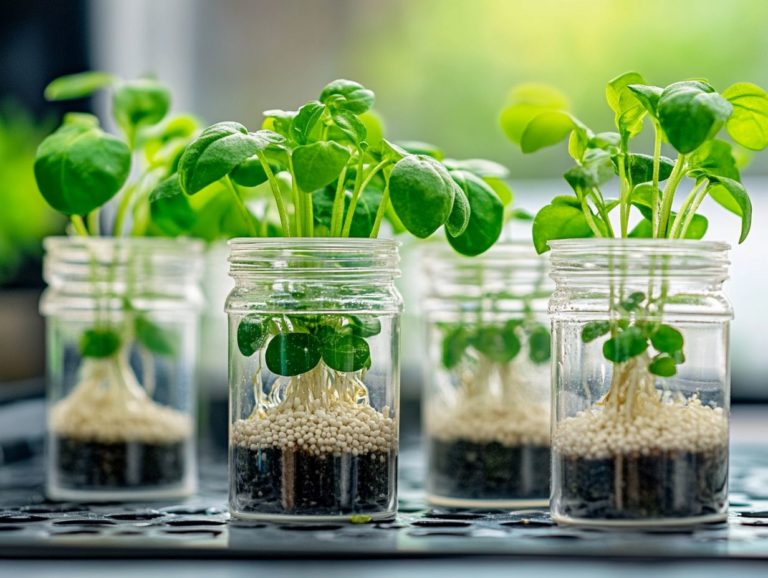The Best Hydroponic Nutrients for Leafy Greens
Hydroponic gardening presents an exceptional opportunity for you to cultivate lush, vibrant leafy greens without the need for soil. To succeed, you must understand the essentials of the right nutrients.
This article delves into the crucial nutrients your plants require, making clear distinctions between macronutrients and micronutrients, while exploring the merits of organic versus synthetic options.
It will guide you in selecting the best nutrients for your greens, cover application methods, troubleshoot common deficiencies, and offer tips to maximize nutrient absorption.
Ready to transform your gardening experience? Let s dive in!
Contents
Key Takeaways:

- Hydroponic nutrients are essential for the growth and development of leafy greens in a soilless environment, providing key elements like nitrogen, phosphorus, potassium, calcium, and magnesium.
- Choose the right nutrients based on plant type, growth stage, and nutrient balance to ensure optimal results.
- Proper application and dosage of nutrients, along with troubleshooting nutrient deficiencies, can help maximize nutrient absorption and promote healthy plant growth.
Discover the Essential Nutrients for Your Hydroponic Garden!
Hydroponic nutrients are the essential elements you need to foster healthy plant development in nutrient solutions, enabling optimal growth in your hydroponic systems. Unlike traditional soil-based gardening, these nutrients are key to your success in achieving the right balance of macronutrients and micronutrients, such as nitrogen, phosphorus, potassium, calcium, and magnesium. These elements are vital for boosting chlorophyll production and effective root development in your plants, enhancing their overall health.
Managing the electrical conductivity (EC) a measure of how well the nutrient solution can conduct electricity, which helps gauge nutrient levels and pH of the nutrient solution is fundamental to preventing deficiencies and ensuring your plants thrive in this controlled environment.
Proper formulations often include specialized nutrient solutions like General Hydroponics or Flora Series, designed to meet the varying needs of your plants throughout their growth stages. For further insights, check out the top hydroponic systems and their nutrient needs. Keep an eye out for common nutrient deficiencies, such as nitrogen deficiency, which leads to yellowing leaves, or calcium deficiency, which causes blossom end rot. These issues underscore the importance of careful monitoring.
An imbalanced EC and pH can hinder nutrient uptake, resulting in stunted growth or poor yield.
Test these parameters regularly to ensure your plants are thriving! By making the necessary adjustments, you can create an ideal environment that maximizes your crops’ potential and enhances overall productivity in your hydroponic systems.
Types of Nutrients for Leafy Greens in Hydroponics
When cultivating leafy greens in a hydroponic system, understanding the nuances of nutrient types is essential for achieving robust growth and impressive yields. You’ll find that both macronutrients and micronutrients, including calcium and magnesium, are crucial to the vibrant development of vegetables like lettuce.
The macronutrients cater to their primary nutritional requirements, while the micronutrients play a vital role in various physiological functions, ensuring your nutrient solution remains perfectly balanced.
Macronutrients vs. Micronutrients
Macronutrients are essential for your plants’ health and growth in hydroponic systems. You ll need larger quantities of macronutrients like nitrogen, phosphorus, potassium, calcium, and magnesium. These nutrients are vital for fundamental processes such as photosynthesis.
Micronutrients, while required in smaller amounts, play crucial roles in critical biochemical reactions necessary for optimal plant development.
If you experience a macronutrient deficiency, you might notice stunted growth, yellowing leaves, and poor fruit production. These issues can significantly impact your overall yield. Conversely, a shortage of micronutrients, such as iron or zinc, could result in chlorosis or delayed flowering.
To manage nutrient ratios effectively in your hydroponic setup, regularly monitor solution pH and electrical conductivity (EC). This ensures your plants receive a balanced supply of both macronutrients and micronutrients. By adjusting the nutrient solution based on your periodic assessments, you can foster a thriving environment that maximizes yields.
Organic vs. Synthetic Nutrients
The debate over organic versus synthetic nutrients in hydroponics revolves around their influence on plant growth, health, and flavor. Organic nutrients, sourced from nature, can boost soil biodiversity and are often favored by gardening enthusiasts.
On the other hand, synthetic nutrients provide precise ratios and immediate availability. This ensures that your plants absorb the nutrients they need in a carefully controlled hydroponic setting.
Both organic and synthetic nutrients have their perks and drawbacks. For example, organic solutions like fish emulsion and seaweed extract can enhance flavor and encourage beneficial microbial activity, giving your hydroponic systems a natural boost. However, they may take longer to release nutrients, potentially slowing growth.
Popular synthetic products, such as the General Hydroponics Flora Series, are designed for rapid absorption. However, they might not deliver the complex flavors typically found in organically grown crops. The health of plants nourished with synthetic nutrients often depends on vigilant monitoring. If imbalances occur, it can lead to nutrient lockout when plants cannot absorb necessary nutrients, jeopardizing your efforts. For those looking to explore alternatives, consider checking out the best nutrient brands for hydroponic gardens.
Choosing the Right Nutrients for Leafy Greens

Choosing the perfect nutrients can make your leafy greens thrive! It’s essential for optimizing growth and achieving impressive yields. Consider factors like the specific type of plant, its growth stage, and the composition of your nutrient solution, which should have proper ratios of macronutrients and micronutrients.
By doing this, you can ensure that your plants receive a perfectly balanced array of nutrient sources for hydroponic systems that are vital for their health and development.
Factors to Consider
When selecting nutrients for hydroponic leafy greens, several critical factors shape your decision-making process. The environmental conditions of your growing space, the specific plant species, pH levels, and the electrical conductivity (EC) of the nutrient solution all play vital roles. Understanding how these elements interact enables you to cultivate healthy plants that deliver consistently high yields.
The interplay between these factors is crucial, as they directly influence nutrient availability and absorption within the plant’s system. For instance, the pH of the nutrient solution affects nutrient solubility, determining which ones are readily available for absorption. Monitoring EC levels also acts as an indicator of nutrient concentration, ensuring your plants receive just the right balance.
To promote optimal growth, regularly check and adjust these parameters. Use pH up or down solutions to stabilize acidity levels when needed, and dilute nutrient solutions if EC readings indicate over-concentration. For those looking to enhance their nutrient management, exploring the best nutrient management apps for hydroponics can be beneficial. Mastering these techniques will create an environment that supports robust leafy green growth and maximizes yield quality.
Application and Dosage of Nutrients
The precise application and dosage of nutrients are vital for the success of hydroponic systems. They greatly influence both plant growth and yield.
To attain optimal results, you must grasp the specific nutrient needs of your plants. Understanding how to accurately measure and deliver these nutrients in the hydroponic environment is essential.
Methods for Feeding Nutrients to Plants
You have various methods for delivering nutrients to plants in hydroponic systems. Each method is designed to optimize nutrient absorption and encourage vigorous growth.
Techniques such as liquid fertilizers, drip feeding systems, and air-based systems each present unique advantages depending on the plant species and your desired outcomes.
Take leafy greens like lettuce and spinach, for example. They flourish remarkably in deep water culture, where their roots remain submerged in nutrient-rich water, ensuring constant access to essential elements.
On the other hand, a drip system may be more fitting for varieties that thrive in drier conditions, as it allows for precise control over moisture levels while delivering nutrients directly to the roots.
Adjust your nutrient levels based on how your plants look and grow. A healthy plant may need more nutrients, while a struggling one may need less.
Monitoring pH levels and ensuring good aeration will further improve nutrient delivery. This helps your plants reach their fullest potential!
Troubleshooting Nutrient Deficiencies
Troubleshooting nutrient deficiencies in hydroponic systems such as calcium or nitrogen deficiencies is crucial for ensuring optimal plant health and maximizing yields.
By recognizing symptoms of deficiency like yellowing leaves or stunted growth you enable yourself to implement timely solutions that restore nutrient balance and promote vigorous plant development.
Common Issues and Solutions

In hydroponic gardening, you may encounter common challenges, such as nutrient deficiencies, that can disrupt plant health and impede growth. By understanding these issues along with their symptoms and potential solutions you can effectively manage and rectify nutrient imbalances.
Environmental stresses, like temperature fluctuations and insufficient light, can complicate nutrient issues. Regularly monitoring water pH and electrical conductivity will help you swiftly identify such imbalances.
Implementing solutions such as:
- Nutrient solution adjustments,
- Proper lighting schedules for maximizing photosynthesis,
- Climate controls.
can help mitigate these risks. By closely observing plant health and assessing leaf color and overall growth patterns, you create an early warning system to catch potential problems.
Establishing a routine of consistent monitoring and prompt adjustments will enable you to maintain optimal conditions within your hydroponic systems.
Maximizing Nutrient Absorption
Maximizing nutrient absorption in hydroponic systems is essential for cultivating optimal plant growth and achieving impressive yields. By implementing effective techniques and strategies, you can greatly enhance the uptake of vital macronutrients and micronutrients.
This will result in healthier plants and more abundant harvests. By following these strategies, you re well on your way to achieving an incredible hydroponic garden! Start making these adjustments today for healthier plants and bigger harvests!
Tips for Optimal Plant Growth
Want your plants to thrive? Here are some tips! Implementing targeted strategies can greatly improve plant health and yields in hydroponic systems. Selecting the right nutrients and maintaining ideal conditions are crucial for effective hydroponic cultivation.
It’s essential to customize your nutrient management for the various types of leafy greens you’re growing. Each species may require different important nutrients. For beginners, exploring the top hydroponic fertilizers can be very helpful. Closely monitor environmental factors like light, temperature, and humidity to create the perfect growth atmosphere.
To further elevate productivity, consider investing in monitoring techniques that track pH levels and electrical conductivity. These tools provide real-time data, enabling you to make prompt adjustments as needed. By adopting this tailored approach, you can ensure that each plant reaches its full potential, resulting in healthier crops and more abundant harvests.
Frequently Asked Questions
1. What are the key nutrients needed for leafy greens to thrive in a hydroponic system?
The best hydroponic nutrients for leafy greens contain a balanced mix of nitrogen, phosphorus, and potassium, along with essential micronutrients like calcium, magnesium, and iron.
2. How often should I change the nutrient solution for my leafy greens in a hydroponic system?
It is recommended to change the nutrient solution every 1-2 weeks for optimal growth and to prevent nutrient deficiencies.
3. Can I use the same hydroponic nutrients for all types of leafy greens?
While some hydroponic nutrients, including specialized blends like hydroponic lettuce fertilizer 8-15-36, may work well for a variety of leafy greens, it is best to choose a nutrient specifically formulated for the type of greens you are growing for maximum results.
4. Are organic hydroponic nutrients better for leafy greens?
Organic hydroponic nutrients can promote plant growth and health, but they may also be pricier and require more maintenance than synthetic nutrients.
5. How can I tell if my leafy greens are experiencing a nutrient deficiency in a hydroponic system?
Symptoms of nutrient deficiencies in leafy greens include yellowing or browning leaves, stunted growth, and wilting. Regularly monitoring your plants and adjusting nutrient levels is crucial.
6. Is it necessary to use a pH balancing solution with hydroponic nutrients for leafy greens?
Yes, maintaining the proper pH level is essential for nutrient absorption in a hydroponic system. Most leafy greens thrive in a pH range of 5.5-6.5.
Ready to improve your hydroponic garden? Start applying these tips today and explore more resources to enhance your hydroponic journey!







